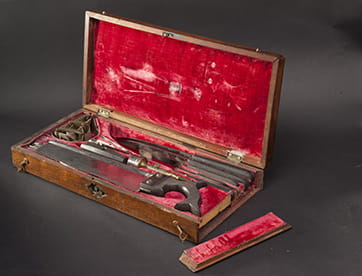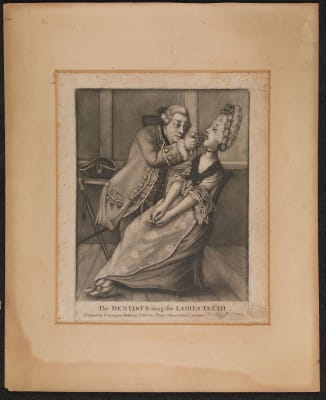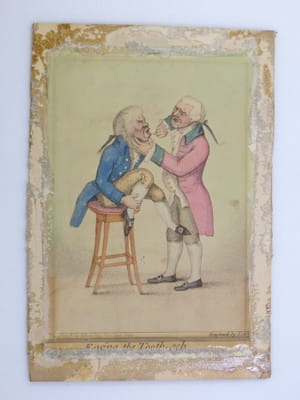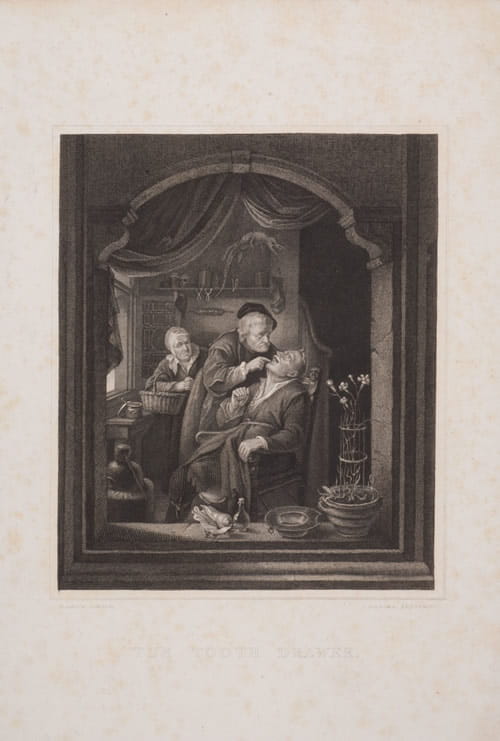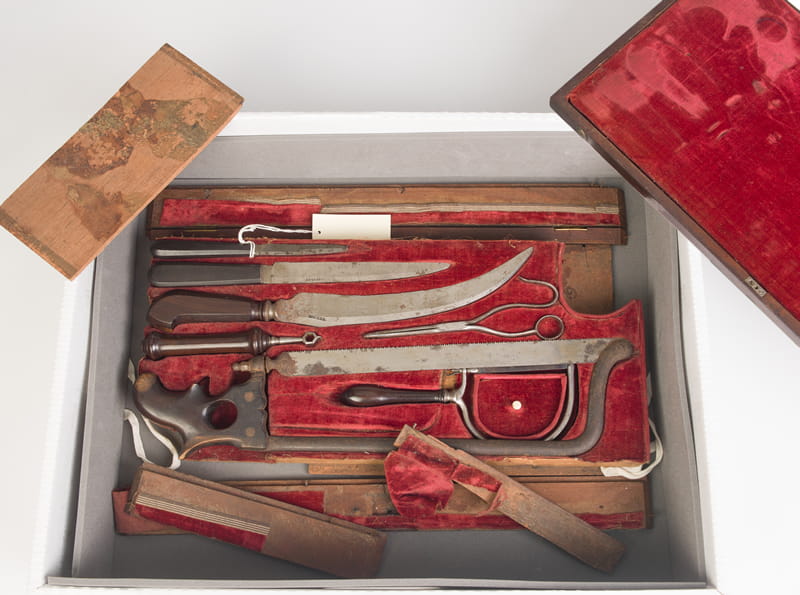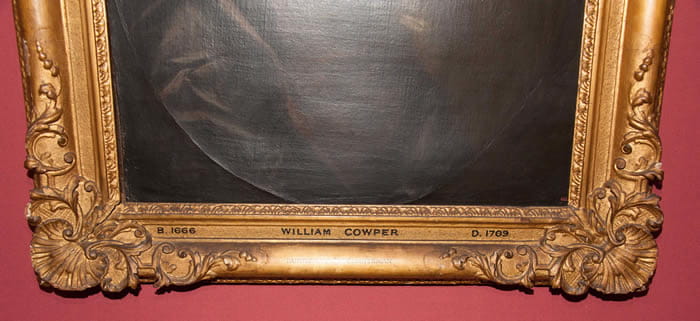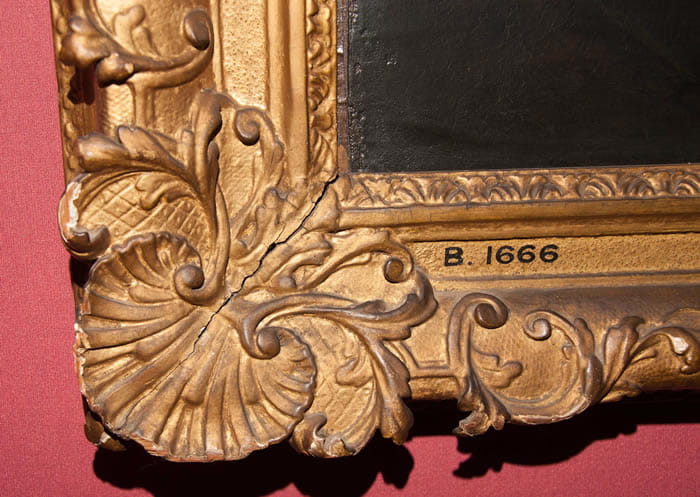Items
Museum
MUS018 - Pocket Surgical Instruments set owned by Explorer Mungo Park
Item ref: MUS18
Surgical instrument set
This set, made by Evans of London, contains instruments for amputation and trepanation - two of the most commonly performed operations in the early nineteenth-century. Almost complete, it comprises of an amputation saw and amputation knives, a metacarpal saw, a screw tourniquet, curved needles, artery forceps, bone cutting forceps, spring skull forceps, a skull saw, a trephine with detachable handle, and a bone brush. The instruments are held within in a fitted walnut case lined with red velvet.
MUS09 Dentist scaling the Ladies Teeth
RCSSC/P 3214 Caricature of an eighteenth-century dentist using a tooth scraper on a female patient, printed for Carington Bowles, London, probably 1770s or 1780s.
Mezzotint, 20cm by 25cm
MUS10 Easing the Tooth Ache
RCSSC/P 3216 Caricature of a dentist pulling a patient's tooth, engraved by T. As (James Gilray), and published by H Humphrey, 1796.
Coloured stipple engraving, cropped, 13.6cm by 20cm
MUS11 Tooth Drawer
Caricature of a dentist pulling a patient's tooth engraved by T. As (James Gilray), and published by H Humphrey, 1796. Coloured stipple engraving, cropped, 13.6cm by 20cm.
MUS12 Mid to late 18th century British amputation set
RCSIC/I 51: The set includes a bow amputation saw with a separate key to tighten or loosed the saw’s blade, a metacarpal saw, forceps for tying ligatures, a curved amputation knife, a part curved amputation knife, a bistoury, and three suture needles stored under an ivory handled lid. The tenaculum is missing. Some instruments are made by Savigny, others are marked by Bodker.
MUS13 Frame - painting of William Cowper
Portrait painting of William Cowper
Treatment required:
To surface clean the pictures frame, dust the back of the painting, secure the stretcher keys, line the frame rebate with felt, secure the painting back into the frame with brass strips and balsa spacing and fasten a piece of Melinex onto the back of the frame.
Estimated conservation cost: £150
MUS14 Portrait of Astley Paston Cooper, oil on canvas, by Thomas Lawrence, unsigned, 1828
Item ref: MUS14
The son of a Norfolk clergyman, Astley Cooper (1768-1841) trained in London under Henry Cline and also attended John Hunter's lectures. In 1800 he was appointed surgeon to Guy's Hospital. Cooper became one of the best known – and best paid – surgeons of his generation. He received a baronetcy for his success in treating George IV and was subsequently appointed sergeant surgeon to George IV, William IV and Queen Victoria. He served as president of the Royal College of Surgeons in 1827and 1836. In addition to his surgical practice Cooper carried out studies on anatomy, pathology and physiology; he was elected a vice-president of the Royal Society in 1830.
Sir Thomas Lawrence PRA FRS (1769 –1830) was a leading English portrait painter and the fourth president of the Royal Academy.
MUS16 - Charlotte Waite’s Samplers
Item ref: MUS16
In June 1848, Charlotte Waite was injured while falling from a carriage seat in Saltburn, North Yorkshire. She was only 11 years old. Surgeons had no choice but to amputate her leg. She made these two small cross-stitch samplers to commemorate the operation. In some respects, Charlotte was lucky; she had access to anaesthetic. Her surgery was performed just 7 months after the Edinburgh Surgeon, James Young Simpson, first reported the anaesthetic qualities of chloroform, and18 months after the first operation under ether in Britain. Charlotte made a good recovery from the amputation and went on to raise ten children.
MUS17 - The Council of the College 1884-85’. This group portrait by H J Brooks (1887)
Item ref: MUS17
Description:
This group portrait by Henry Jamyn Brooks (1887) has been selected for conservation as it's the earliest group portrait of the RCS Council; it was produced in a format that has been repeated numerous times until the present day.
The painting emphasises the authority of the College and the professional status of surgeons during the late Victorian period. The pile of books in the foreground signifies the surgeons’ scholarship and specialist knowledge, while the paintings in the background which include the famous portrait of John Hunter by Joshua Reynolds place the Council members in a long lineage of esteemed practitioners.
It requires conservation prior to display in the new museum that is to reopen at the end of 2021.
Total cost of conservation breakdown:
Conservation of the painting - £2,800 + VAT
Frame conservation to include build up rebate depth - £830 + VAT
Supply and fit 4.4mm laminated low reflect glass - £1,130 +VAT
Outstanding conservation cost: £3,255 + VAT
MUS15 - Case of post-morem instruments, c1800
Item ref: MUS15
This set was fully funded for conservation by the Conserve our Collections summer appeal. The set was dirty, the case lid almost detached and the covering was peeling and the silk lid lining had shattered.
The instruments - consisting of forceps, scalpels, scissors, saws, needles, a skull rest and a wrench were tarnished and corroded, and their handles were stained.
The case and instruments have been cleaned; a protective wax coating applied to the metal surfaces of the instruments and buffed to polish; the fraying silk textile lining has been re-laid and secured; the lifting case covering and loose lid hinges has been stabilised.

